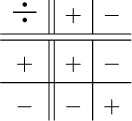3.21 Division rules
Lastly consider division. Dividing 8 by 2 means ‘How many times does 2 go into 8?’ or ‘What must you multiply 2 by to get 8?’. The answer is 4.
So to find 8 ÷ −2, you need to ask ‘What do I have to multiply −2 by to get 8?’. The answer is −4, since −2 × −4 = 8.
So 8 ÷ −2 = −4.
Similarly, to find −8 ÷ −2 you need to ask ‘what do I have to multiply −2 by to get −8?’ and the answer is 4, since −2 × 4 = −8.
So −8 ÷ −2 = 4.
Using this sort of argument you can work out the rules for division of and by negative numbers. They are remarkably similar to those for multiplication (as you might expect, since they are inverse processes).
Multiplying or dividing a positive number by a positive number gives a positive answer.
Multiplying or dividing a negative number by a positive number gives a negative answer.
Multiplying or dividing a positive number by a negative number gives a negative answer.
Multiplying or dividing a negative number by a negative number gives a positive answer.

The last one is the most difficult to remember. If you are in doubt, you can always use your calculator to check.
These rules may be summarised as follows.
Multiplying or dividing two numbers of the same sign gives a positive answer.
Multiplying or dividing two numbers of different signs gives a negative answer.
